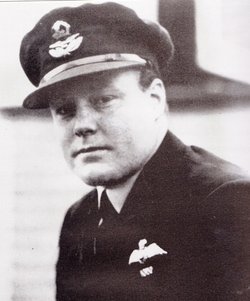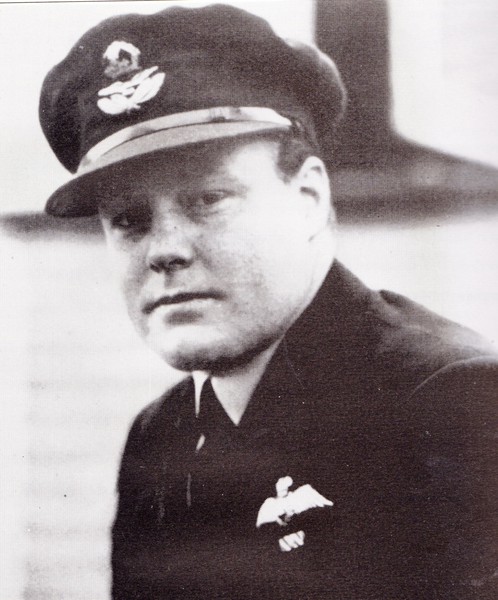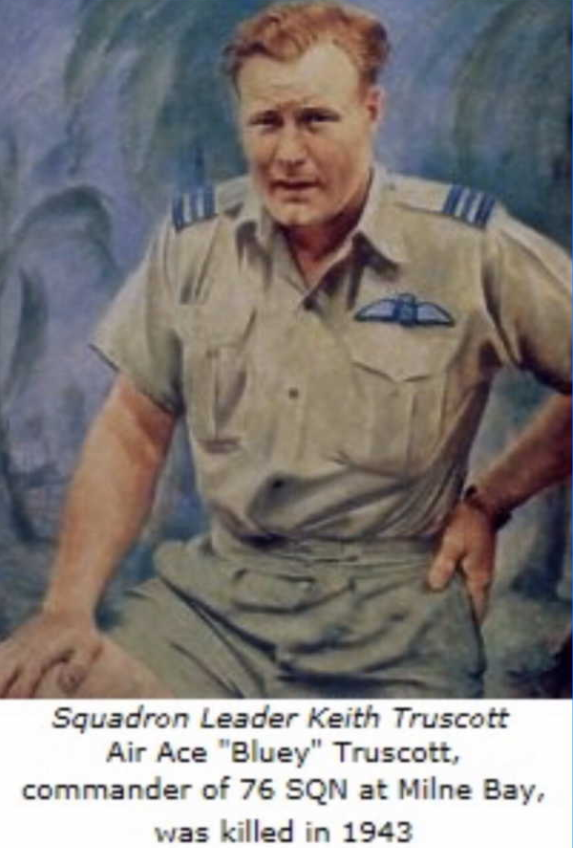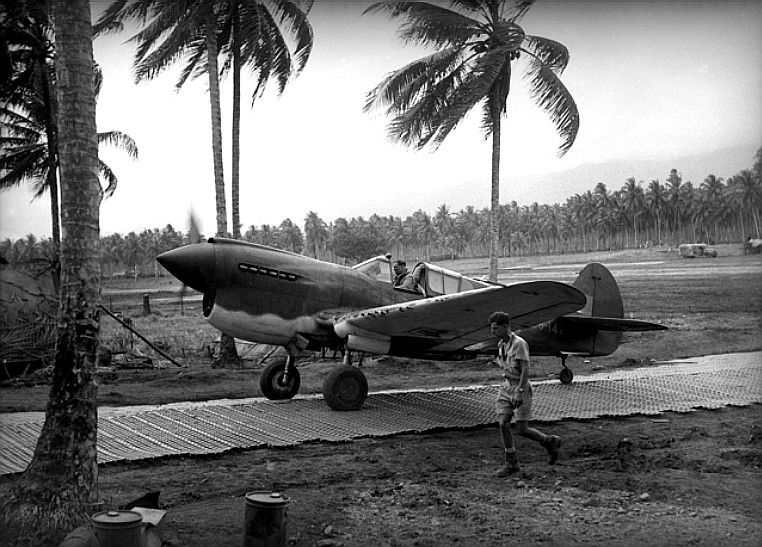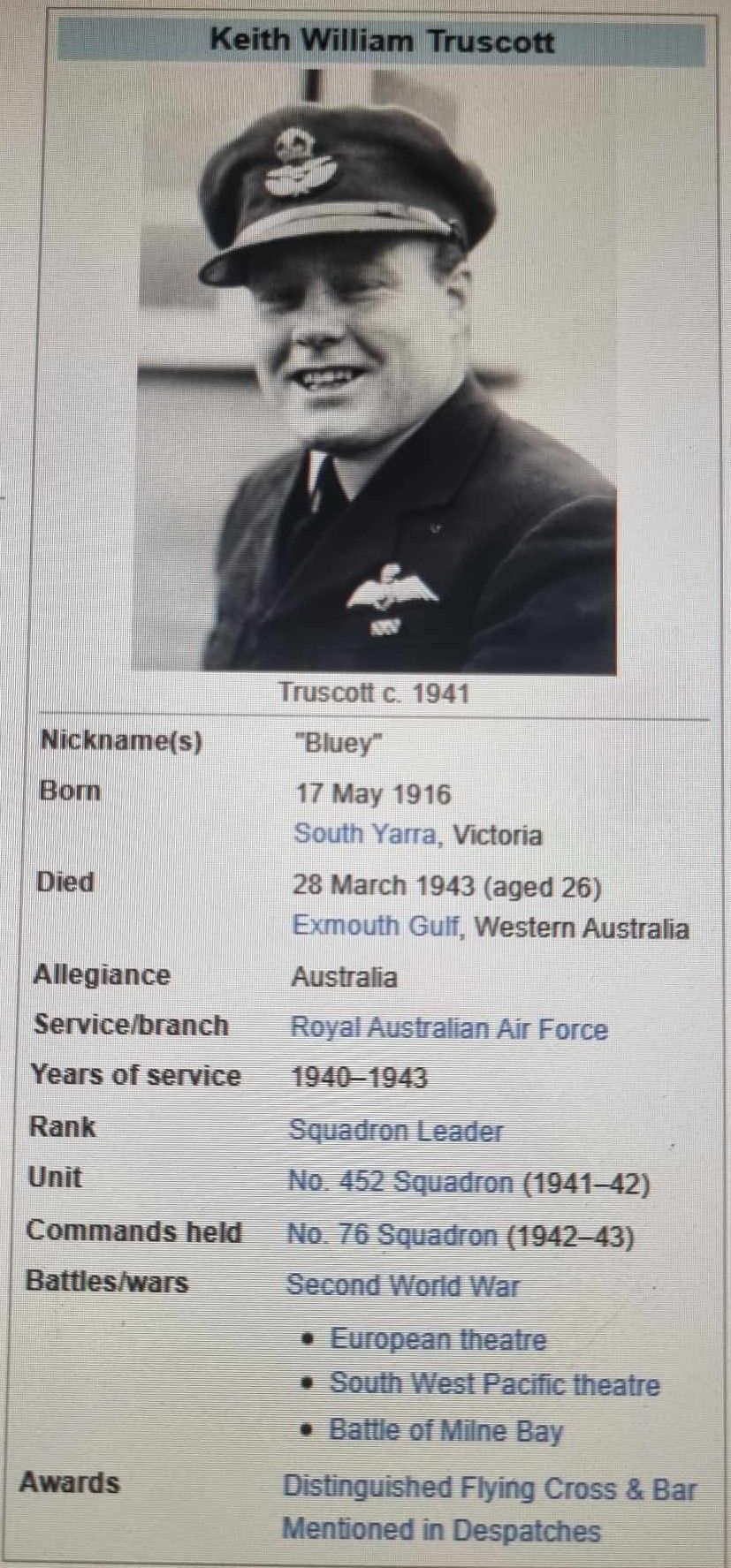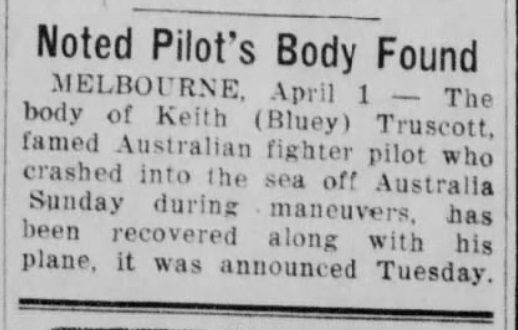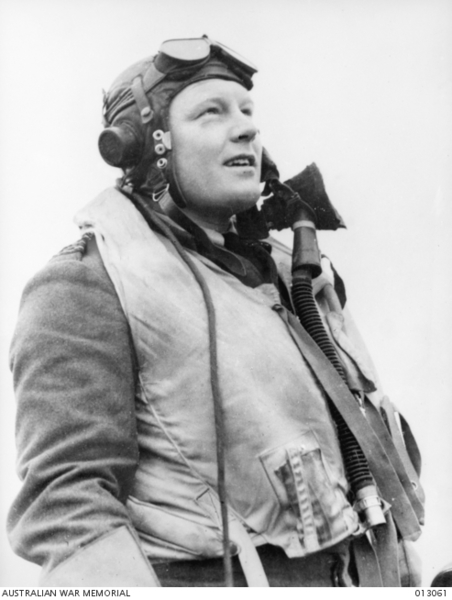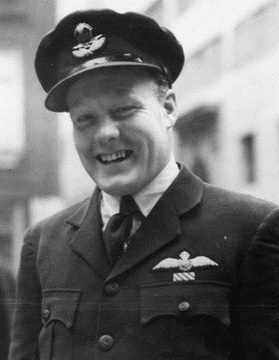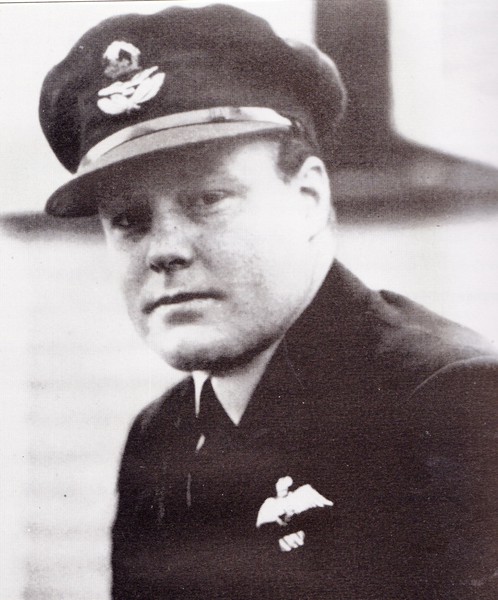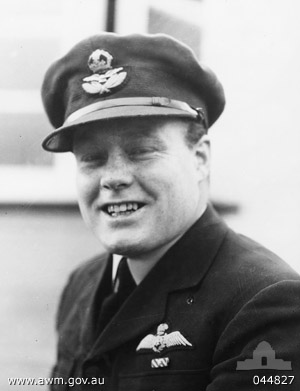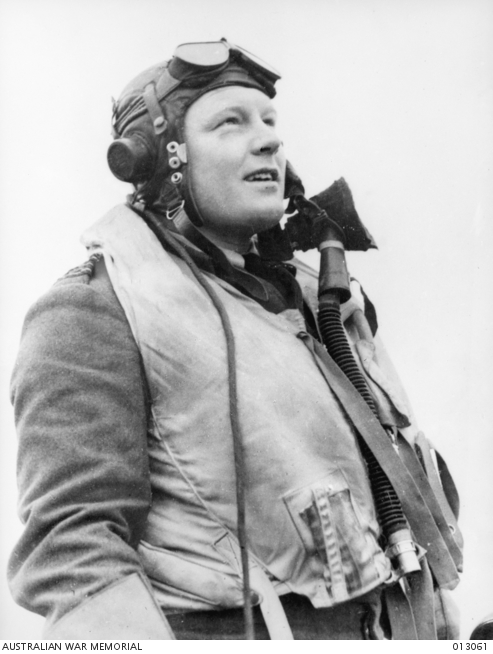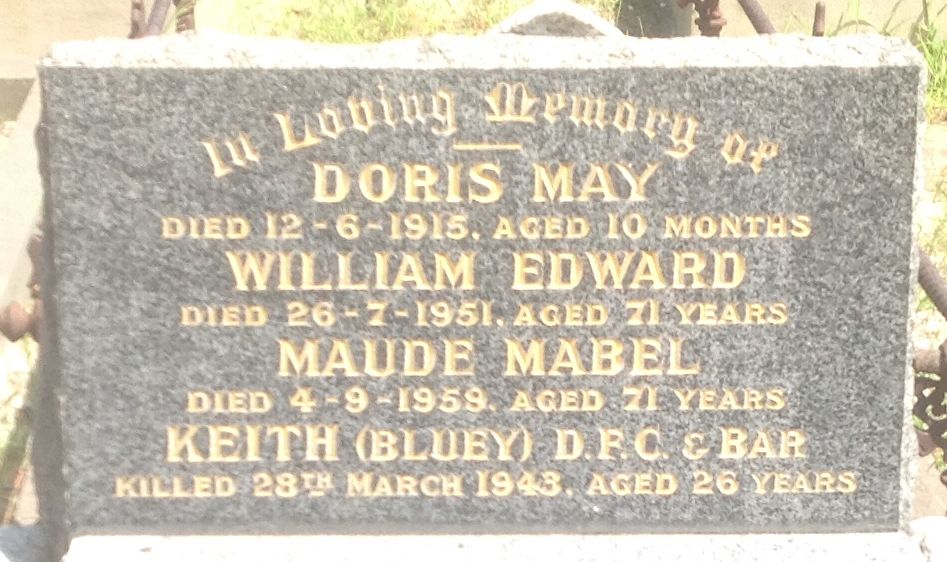Squadron Leader Bluey Truscott is the equal third highest scoring Australian ace of WWII with a tally 16 confirmed kills and unofficially 20.5 kills. A Spitfire Aircraft he once flew is on display at the Australian War Memorial, Canberra. Truscott Airfield, located on the Anjo Peninsula in the extreme north of Western Australia, is named in his honour.
~~~~Military Service, Australian Military Forces, Royal Australian Air Force, RAAF~~~~~~
Service Number:--- 400213
Enlisted in RAAF:--- 21st July 1940, Melbourne, Victoria.
Religion:--- Church of England
Martial Status:--- Single
Next of kin:--- Father, Mr William Edwin, 5 Tyronne St, South Yarra, Melbourne.
Last Rank:--- Squadron Leader
Last Unit:--- No. 76 Squadron
Born:--- Prahran, Victoria, Australia, 17th May 1916
Home Town:--- South Yarra, Melbourne, Victoria
Civilian Employment:--- School Teacher/Accounts Clerk
Fate:---Died in flying accident, No. 76 Squadron in P40 Kittyhawk aircraft A29-150 in Exmouth Gulf, Western Australia, on 28th March 1943.
Burial:--- Perth War Cemetery and Annex (Karrakatta War Cemetery WA)
Parents:--- William Edward and Maude Mabel Truscott. of South Yarra, Victoria
Other details:---Pilot, No. 452 Squadron, 11 Fighter Group, UK, 1941
Awarded the Distinguished Flying Cross (DFC), 17th October 1941 (Citation Title: No. 452 Squadron). Commanding Officer, No. 452 Squadron, UK, 25th February 1942 – 18th March 1942. Awarded the Bar to the Distinguished Flying Cross, 27 March 1942 (Citation Title: No. 452 Squadron). Commanding Officer, No. 76 Squadron, Milne Bay PNG, Strauss Field NT, Onslow WA, Potshot Airfield Northwest Cape WA, 27 August 1942 – 28 March 1943
DFC Citation:--- "This officer joined No. 452 Squadron after a period of training in Australia and Canada. He has participated in many operational sorties against the enemy and has displayed great courage and determination throughout. Pilot Officer Truscott has destroyed at least six enemy aircraft." (London Gazette 17 October 1941 page 6035)
Citation for the Bar to the DFC:--- "This officer is a skilful and courageous fighter pilot. Since May 1941, he has participated in a large number of sorties and convoy escorts. Throughout he has shown
Fine fighting spirit and in combat destroyed 11 aircraft, probably destroyed three, and damaging two further hostile aircraft. Squadron Leader Truscott participated in an attack on an enemy destroyer which was left in a damaged condition with black smoke issuing from behind the bridge. The next day he assisted in the destruction of a German float plane." (London Gazette 27 March 1942 page138)
Civilian Achievements:--- Before enlisting, Squadron Leader Truscott was a prominent Australian Rules Football player with the Melbourne Football Club.
Details of Death:---On March 28th 1943 I was AMM / First Class Plane Captain of Crew 18 of VP l0l based at Perth, Australia. I was at advanced base Exmouth Gulf on the sea plane Tender USS Willie B Preston also the USS Childs was there. At 1630 I was standing on the deck waiting for our PBY-5s (Catalina aircraft) to return from Patrol. Squadron Leader Keith (Bluey) Truscott was flying in from R.A.A.F. Base Pot Shot in a Kittyhawk. He flew under and slightly ahead of VP 101's PBY-5 as it was on the final approach to land in the sea. The water was glassy – Bluey misjudged the distance, hit the water, yanked back on the stick, the plane rose with a right spiral, the engine cut, caught and made another spiral, the engine cut, caught and made a third spiral, the engine cut then plunged into the bay. That night I was the mechanic to stay aboard, we listened to Tokyo Rose news and music, she said the Imperial Japanese Air Force had shot down Australian Ace, Squadron Leader Bluey Truscott and that they also shot down an American PBY Patrol plane.
Eyewitness Account of Squadron Leaders Truscott's fatal accident from Mr. Dan Dennison of Chula Vista California as written to Mrs Avis Koenig (see Bibliography)
~~~~~~~~~~~~~~~~~~~More Bio details~~~~~~~~~~~~~~~~~~~~~~~~~~~~~~~~~~~
Squadron Leader Keith "Bluey" Truscott, RAAF. A talented footballer, Bluey joined the RAAF in 1940. He was not a natural pilot and his heavy landings saw him almost fail his initial flight training.
He was eventually posted to 452 squadron RAAF, flying Spitfires in May 1941. Over the next three months, his score rose to 11 enemy aircraft destroyed, for which he was awarded the Distinguished Flying Cross. Shortly thereafter, he was posted back to Australia where he joined 76 Squadron which was being reformed after it's defence of Port Moresby. Before the squadron deployed, Bluey played a game of football, for his old club, the Melbourne Demons. Lacking match fitness, he struggled to keep up, but the fans cheered him just the same. After the game he was asked if he would play again, but he simply replied that the game was "too dangerous"!Bluey commanded 76 Squadron through the Milne bay campaign during late 1942, increasing his score to 16 aircraft destroyed with 3 probable and 3 damaged by the time the Squadron was transferred to Darwin. He was then transferred to a "quiet" sector in Western Australia.On March 28, 1943, whilst on a training flight in his Kittyhawk, Bluey made a mock attack on a Catalina flying boat. He misjudged his altitude and crashed into the ocean. He was killed instantly.Bluey Truscott was 26 years old and aWorld War II ace fighter pilot. He was also an Australian rules footballer with the Melbourne Football Club. After joining the Royal Australian Air Force in 1940, he became the second highest Australian World War II ace credited with 20 confirmed victories and 5 unconfirmed victories. After completing flying training in Canada, Truscott served in Britain flying Spitfire fighters. He returned to Australia in early 1942 and served in New Guinea, where he fought during the climactic Battle of Milne Bay. He was killed in a flying accident off the coast of Western Australia.
Squadron Leader Bluey Truscott is the equal third highest scoring Australian ace of WWII with a tally 16 confirmed kills and unofficially 20.5 kills. A Spitfire Aircraft he once flew is on display at the Australian War Memorial, Canberra. Truscott Airfield, located on the Anjo Peninsula in the extreme north of Western Australia, is named in his honour.
~~~~Military Service, Australian Military Forces, Royal Australian Air Force, RAAF~~~~~~
Service Number:--- 400213
Enlisted in RAAF:--- 21st July 1940, Melbourne, Victoria.
Religion:--- Church of England
Martial Status:--- Single
Next of kin:--- Father, Mr William Edwin, 5 Tyronne St, South Yarra, Melbourne.
Last Rank:--- Squadron Leader
Last Unit:--- No. 76 Squadron
Born:--- Prahran, Victoria, Australia, 17th May 1916
Home Town:--- South Yarra, Melbourne, Victoria
Civilian Employment:--- School Teacher/Accounts Clerk
Fate:---Died in flying accident, No. 76 Squadron in P40 Kittyhawk aircraft A29-150 in Exmouth Gulf, Western Australia, on 28th March 1943.
Burial:--- Perth War Cemetery and Annex (Karrakatta War Cemetery WA)
Parents:--- William Edward and Maude Mabel Truscott. of South Yarra, Victoria
Other details:---Pilot, No. 452 Squadron, 11 Fighter Group, UK, 1941
Awarded the Distinguished Flying Cross (DFC), 17th October 1941 (Citation Title: No. 452 Squadron). Commanding Officer, No. 452 Squadron, UK, 25th February 1942 – 18th March 1942. Awarded the Bar to the Distinguished Flying Cross, 27 March 1942 (Citation Title: No. 452 Squadron). Commanding Officer, No. 76 Squadron, Milne Bay PNG, Strauss Field NT, Onslow WA, Potshot Airfield Northwest Cape WA, 27 August 1942 – 28 March 1943
DFC Citation:--- "This officer joined No. 452 Squadron after a period of training in Australia and Canada. He has participated in many operational sorties against the enemy and has displayed great courage and determination throughout. Pilot Officer Truscott has destroyed at least six enemy aircraft." (London Gazette 17 October 1941 page 6035)
Citation for the Bar to the DFC:--- "This officer is a skilful and courageous fighter pilot. Since May 1941, he has participated in a large number of sorties and convoy escorts. Throughout he has shown
Fine fighting spirit and in combat destroyed 11 aircraft, probably destroyed three, and damaging two further hostile aircraft. Squadron Leader Truscott participated in an attack on an enemy destroyer which was left in a damaged condition with black smoke issuing from behind the bridge. The next day he assisted in the destruction of a German float plane." (London Gazette 27 March 1942 page138)
Civilian Achievements:--- Before enlisting, Squadron Leader Truscott was a prominent Australian Rules Football player with the Melbourne Football Club.
Details of Death:---On March 28th 1943 I was AMM / First Class Plane Captain of Crew 18 of VP l0l based at Perth, Australia. I was at advanced base Exmouth Gulf on the sea plane Tender USS Willie B Preston also the USS Childs was there. At 1630 I was standing on the deck waiting for our PBY-5s (Catalina aircraft) to return from Patrol. Squadron Leader Keith (Bluey) Truscott was flying in from R.A.A.F. Base Pot Shot in a Kittyhawk. He flew under and slightly ahead of VP 101's PBY-5 as it was on the final approach to land in the sea. The water was glassy – Bluey misjudged the distance, hit the water, yanked back on the stick, the plane rose with a right spiral, the engine cut, caught and made another spiral, the engine cut, caught and made a third spiral, the engine cut then plunged into the bay. That night I was the mechanic to stay aboard, we listened to Tokyo Rose news and music, she said the Imperial Japanese Air Force had shot down Australian Ace, Squadron Leader Bluey Truscott and that they also shot down an American PBY Patrol plane.
Eyewitness Account of Squadron Leaders Truscott's fatal accident from Mr. Dan Dennison of Chula Vista California as written to Mrs Avis Koenig (see Bibliography)
~~~~~~~~~~~~~~~~~~~More Bio details~~~~~~~~~~~~~~~~~~~~~~~~~~~~~~~~~~~
Squadron Leader Keith "Bluey" Truscott, RAAF. A talented footballer, Bluey joined the RAAF in 1940. He was not a natural pilot and his heavy landings saw him almost fail his initial flight training.
He was eventually posted to 452 squadron RAAF, flying Spitfires in May 1941. Over the next three months, his score rose to 11 enemy aircraft destroyed, for which he was awarded the Distinguished Flying Cross. Shortly thereafter, he was posted back to Australia where he joined 76 Squadron which was being reformed after it's defence of Port Moresby. Before the squadron deployed, Bluey played a game of football, for his old club, the Melbourne Demons. Lacking match fitness, he struggled to keep up, but the fans cheered him just the same. After the game he was asked if he would play again, but he simply replied that the game was "too dangerous"!Bluey commanded 76 Squadron through the Milne bay campaign during late 1942, increasing his score to 16 aircraft destroyed with 3 probable and 3 damaged by the time the Squadron was transferred to Darwin. He was then transferred to a "quiet" sector in Western Australia.On March 28, 1943, whilst on a training flight in his Kittyhawk, Bluey made a mock attack on a Catalina flying boat. He misjudged his altitude and crashed into the ocean. He was killed instantly.Bluey Truscott was 26 years old and aWorld War II ace fighter pilot. He was also an Australian rules footballer with the Melbourne Football Club. After joining the Royal Australian Air Force in 1940, he became the second highest Australian World War II ace credited with 20 confirmed victories and 5 unconfirmed victories. After completing flying training in Canada, Truscott served in Britain flying Spitfire fighters. He returned to Australia in early 1942 and served in New Guinea, where he fought during the climactic Battle of Milne Bay. He was killed in a flying accident off the coast of Western Australia.
Family Members
Sponsored by Ancestry
Advertisement
Advertisement
